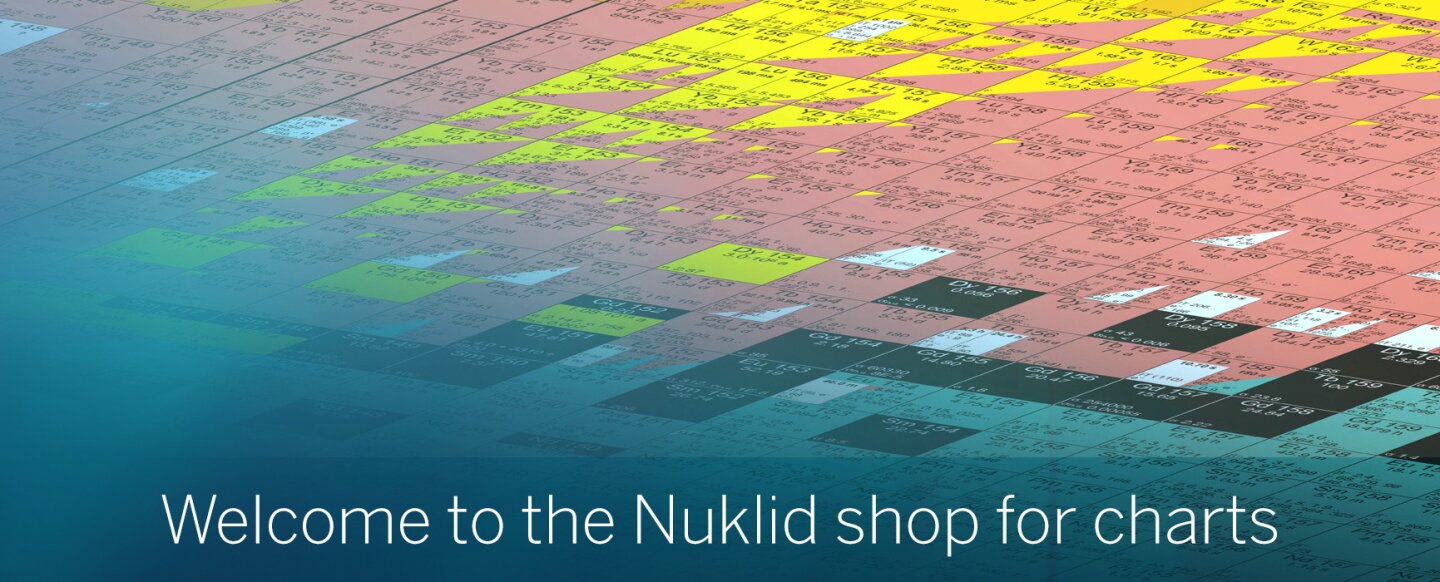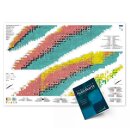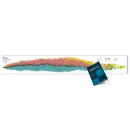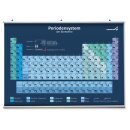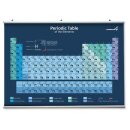


11th revised new edition 2022 of the "Karlsruhe Nuclide Chart" with accompanying booklet available now.
The Karlsruhe Nuclide Chart has been published in an extended reprint and contains new and updated radioactive decay and thermal neutrons as well as cross-sectional data for 1035 nuclides including 82 new nuclides. In total, nuclear data on 4122 experimentally observed ground states and isomers are presented.
Due to its clear presentation, the Karlsruhe Nuclide Chart is an important tool for radio and nuclear chemistry as well as radiation protection. It is used in all areas in which radionuclides are used, such as nuclear medicine or materials research.
The new booklet accompanying the Karlsruhe Nuclide Chart contains the multilingual explanation of the Nuclide Chart in German, English, French and Spanish.
Poster Periodic Table of Elements
The first edition of the periodic table of the elements of Nucleonica is a new product that complements our Karlsruhe nuclide diagram in its various shapes and sizes and shows all known chemical elements and their properties and is widely used in chemistry, physics and other sciences. The data in the table are scientifically confirmed by Nucleonica and contain the information about the atomic number, the chemical symbol and the element name. In addition, the latest data on relative atomic weight, density, melting and boiling points, ionization potential and aggregate state (solid, liquid, gaseous) are given at room temperature for 118 elements. The table is colour-coded according to the type of element (e.g. type of metal, noble gases, halogens, etc.). By using scalable vector graphics, text and image are sharp and easy to read. The periodic table of elements is available in four languages: English, German, French and Spanish and printed in three sizes: DIN A3, DIN A1 and DIN A0.
Nuklidkarten online kaufen
Eine Nuklidkarte (auch Isotopenkarte, Isotopentafel) ist eine grafische Darstellung aller bekannten Nuklide (Atomsorten). Sie ist für die Kernphysik von ähnlicher Bedeutung wie das Periodensystem der Elemente für die Chemie.
Ein Nuklid ist durch die Anzahlen seiner Protonen und Neutronen bestimmt. Daher bietet sich eine zweidimensionale Darstellung aus kleinen Schriftfeldern an, in denen Namen und wichtige Eigenschaften genannt werden. Es sind verschiedene Anordnungen der Felder möglich. In der meist verwendeten Form nach Segrè wird die Anzahl der Protonen nach oben zunehmend, die der Neutronen nach rechts zunehmend aufgetragen.
Nuklidkarten listen jeweils einige Eigenschaften der Nuklide auf, wie die Massenzahl, Häufigkeit im natürlichen Element, Halbwertszeit, Zerfallsarten und Zerfallsenergien. Oft werden die Nuklide nach ihren Zerfallseigenschaften (stabil, radioaktiv, Zerfallsart, Halbwertszeit-Größenordnung) farbig markiert. Kernisomere lassen sich darstellen, indem das jeweilige Feld in Spalten unterteilt wird.
Discover the brand new Nucleonica Periodic Table Roll Chart now! Made of durable, flat-hanging polyester material including clamping rail and hanging device, this chart is not only robust but also
The Karlsruhe Nuclide Map was first published in 1958 by German radiochemists Walter Seelmann-Eggebert and Gerda Pfennig. At that time, nuclear physics was still a fairly young field of research, and
The first edition of Nucleonica's Periodic Table of the Elements is a new product to complement our Karlsruhe Nuclide Chart in its various forms and sizes. The Periodic Table of the Elements displays all known chemical elements and their properties and is widely used in chemistry, ...
